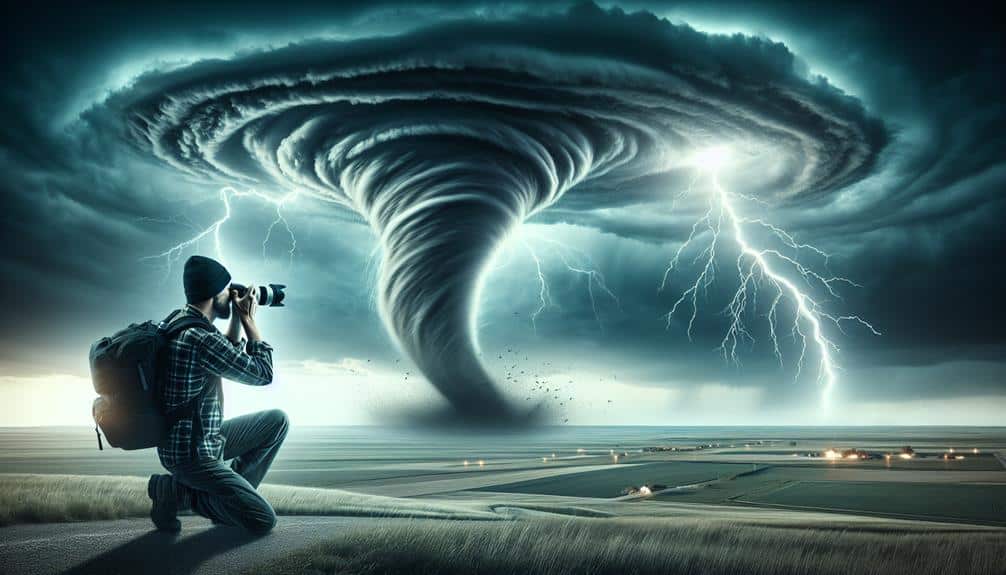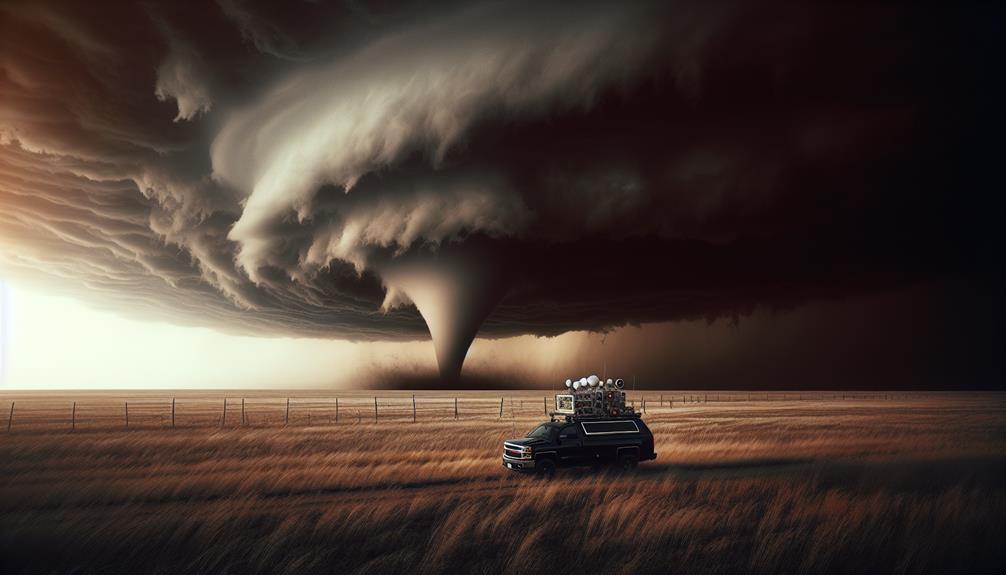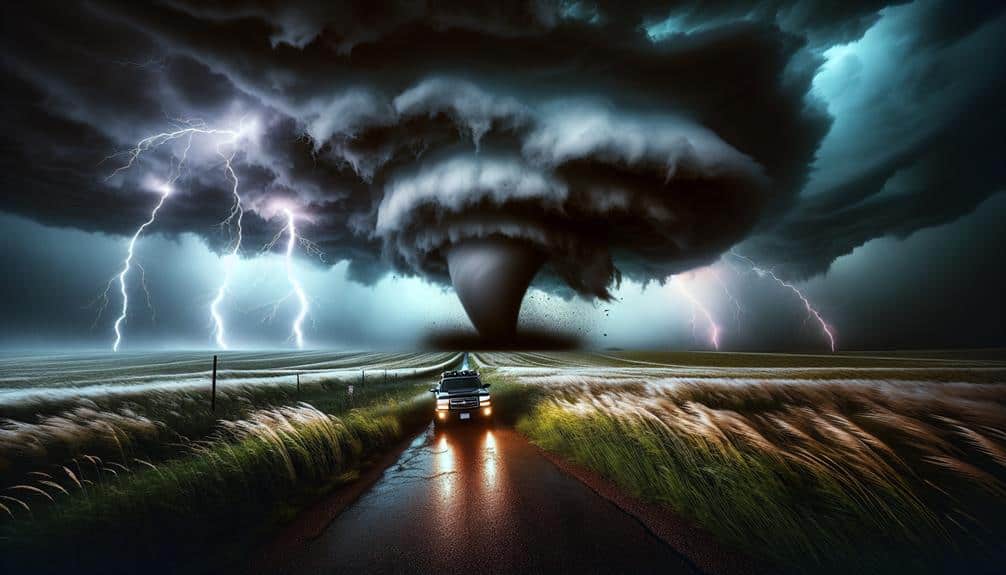We set out with our high-resolution cameras and navigate remote areas to capture the raw power and fleeting beauty of extreme weather. Storm chasing photography is essential because it enhances storytelling by weaving intense images into compelling narratives, providing deep emotional connections for viewers. It also contributes valuable meteorological data, aiding scientific research and offering insights into storm structures and climate change. By engaging audiences through powerful visuals and human elements, we create historical records and educational content that highlight the profound impacts of weather on our world. Stay with us to uncover how these visuals shape our understanding and actions.
Key Points
- Captures raw, intense moments of nature's fury, providing authentic visual documentation.
- Enhances storytelling by weaving powerful storm images into emotionally resonant narratives.
- Provides invaluable scientific data and insights for meteorological research and climate science.
- Engages audiences with immersive visuals and a human element for relatability.
Capturing Raw Natural Events
When we're storm chasing, capturing raw natural events demands a meticulous understanding of weather patterns and an unwavering readiness to seize the perfect moment. We analyze satellite data, radar readings, and wind trajectories to anticipate where the most dramatic landscapes will unfold. Our goal is to document those intense moments when nature's fury is on full display—moments that are as fleeting as they're powerful.
We often find ourselves maneuvering through remote areas, where the horizon seems endless, and the sky takes on a life of its own. As towering cumulonimbus clouds gather, the atmosphere becomes electric with anticipation. Our instruments are always at the ready, from high-resolution cameras to anemometers, ensuring that we capture every gust of wind and flash of lightning with precision.
What drives us is the pursuit of freedom—to witness and document these awe-inspiring events without constraints. Each storm offers a unique tableau, from swirling tornadoes tearing through open fields to lightning illuminating jagged mountain ranges. These dramatic landscapes and intense moments aren't just visually stunning; they're raw, unfiltered evidence of nature's power, providing invaluable insights for scientific research and compelling material for documentaries.
Enhancing Storytelling Impact
Understanding how to visually capture these raw natural events is just the beginning; to truly enhance storytelling impact, we must weave these powerful images into narratives that resonate with viewers on a profound emotional level. Visual storytelling enables us to transcend mere documentation, crafting a compelling journey that connects deeply with our audience.
To achieve this, we must focus on several key elements:
- Contextual Background: Providing the setting and circumstances under which these storms occur helps viewers grasp the gravity and significance of the events. This backdrop is essential in creating a detailed story that's not just visually stunning but also contextually rich.
- Human Element: Including personal stories or firsthand accounts from those affected by these storms fosters an emotional connection. This humanizes the raw power of nature, bridging the gap between the viewer and the natural phenomena.
- Narrative Arc: Just like any good story, our documentaries need a beginning, middle, and end. Building a narrative arc around the storm's lifecycle—from formation to aftermath—keeps the audience engaged and invested in the unfolding drama.
Providing Scientific Insights
By delving into the scientific intricacies of storm formation and behavior, we can offer viewers a deeper understanding of these awe-inspiring phenomena. Storm chasing photography isn't just about capturing breathtaking visuals; it's an essential tool for scientific research.
When we chase storms, we gather valuable meteorological data that helps us decode the mysteries of these powerful natural events. Through high-resolution images and videos, we can analyze storm structures, lightning patterns, and tornado formations with unparalleled clarity. This data aids meteorologists in predicting future storms more accurately, potentially saving lives.
We've seen how the swirling masses of clouds, the electrifying bolts of lightning, and the towering supercells provide a wealth of information on atmospheric dynamics. Our footage allows scientists to study variables like wind speed, pressure changes, and temperature fluctuations in real-time. By doing so, we contribute to a deeper, more nuanced understanding of storm systems.
This isn't just about numbers and charts; it's about bringing the raw, untamed power of nature into focus. Our work fuels scientific advancements, making the seemingly unpredictable more predictable, and empowering viewers with knowledge.
Building Audience Engagement
While our scientific contributions are invaluable, capturing the raw power of storms also plays a key role in building audience engagement. The visceral experience of witnessing a storm's fury through visual storytelling can mesmerize viewers, drawing them into the narrative and fostering a deeper connection.
Here's how storm chasing photography boosts audience interaction:
- Immersive Visuals: High-definition images and videos of swirling clouds, lightning strikes, and torrential rain create a sensory overload that pulls viewers in. The dramatic visuals not only hold their attention but also evoke strong emotional responses.
- Human Element: Including footage of storm chasers in action adds a relatable human dimension. Seeing real people face the elements enhances the narrative and allows the audience to live vicariously through their daring pursuits.
- Educational Value: By visually explaining meteorological phenomena, we transform complex concepts into digestible content. This makes learning about storms more engaging and accessible, encouraging viewers to explore further.
Creating Historical Records

Storm chasing photography doesn't just capture breathtaking visuals; it creates invaluable historical records that document the evolution of meteorological phenomena over time. By diligently photographing storms, we contribute to historical preservation, offering future scientists and enthusiasts a vivid glimpse into past weather patterns and extreme events. Each storm we chase becomes a piece of the larger puzzle, helping us understand climate change and natural disasters with greater clarity.
In the domain of visual storytelling, these photographs serve as more than just snapshots; they're detailed records that encapsulate the intensity and transformative power of nature. We meticulously catalog the formation, progression, and aftermath of storms, ensuring that every image is a reliable data point. This meticulous approach allows us to track shifts in storm behavior and frequency, providing essential insights into how our planet's climate is changing.
Moreover, these historical records empower us to maintain a sense of freedom, as they offer critical knowledge that can inform better preparation and response strategies for future weather events. By preserving these moments through our lenses, we not only tell compelling stories but also equip society with the tools needed to navigate an ever-changing world.
Showcasing Extreme Weather
When we showcase extreme weather, we capture the dramatic skies that convey the intensity of the storm.
We highlight the impacts on both natural and built environments, providing a detailed analysis of the storm's power.
Capturing Dramatic Skies
Capturing dramatic skies requires a keen understanding of weather patterns and the ability to anticipate the perfect moment when clouds, light, and turbulence create a visually stunning scene. As storm chasers, we meticulously analyze meteorological data, radar images, and satellite observations to predict these awe-inspiring yet volatile conditions.
When aiming to capture dramatic lighting and an intense atmosphere, we follow a systematic approach:
- Analyze Weather Models: We scrutinize weather models to identify potential severe weather hotspots, focusing on areas where atmospheric instability can lead to extraordinary cloud formations and lighting conditions.
- Monitor Real-Time Data: Utilizing real-time radar and satellite feeds, we track evolving storm systems to pinpoint the best time and location for capturing the most dramatic skies.
- Position Strategically: We position ourselves at strategic vantage points, often on elevated terrain or expansive plains, ensuring unobstructed views of the sky's unfolding drama.
Our goal isn't just to document storms but to illustrate the raw power and beauty of nature's extremes. Through our lenses, we bring viewers into the heart of these tempestuous scenes, offering a glimpse of the freedom found in nature's uncompromising spectacles.
The interplay of dramatic lighting and an intense atmosphere creates images that aren't only breathtaking but scientifically invaluable.
Highlighting Weather Impacts
Our mission is to vividly document the profound impacts of extreme weather, capturing the raw essence of nature's most powerful phenomena. As storm chasers, we bear witness to the visceral evidence of climate change, translating it into compelling visual storytelling.
Each captured image or video segment is more than just a representation; it's a pivotal piece of data that illustrates the dramatic transformations occurring in our environment.
Through our lenses, we observe how torrential downpours, violent tornadoes, and relentless hurricanes reshape landscapes and alter ecosystems. The stark contrast between serene, sunlit days and the chaos of a storm underscores the fragility and unpredictability of our climate. We aim to highlight these weather impacts to inform, educate, and inspire action.
Our detailed analysis of extreme weather events provides a vital link between abstract climate science and tangible, real-world consequences. By documenting these phenomena, we create a visual narrative that speaks to the urgency of addressing climate change.
The freedom to explore and capture these moments allows us to contribute to a broader understanding and appreciation of our planet's dynamic systems. Each shot we take is a step towards a more informed and proactive society.
Emphasizing Natural Phenomena
While highlighting weather impacts underscores the consequences of extreme events, emphasizing natural phenomena allows us to showcase the sheer power and awe-inspiring beauty of these occurrences. By capturing these moments, storm chasing photography serves as both an artistic expression and a tool for environmental awareness.
We can convey the magnificence of nature while also reminding viewers of the planet's delicate balance.
Consider the following aspects to enhance our understanding:
- Visual Impact: High-definition images and videos of tornadoes, lightning storms, and hurricanes create a visceral connection. These visuals don't just inform; they captivate and inspire.
- Scientific Insight: Detailed, close-up shots assist meteorologists and climate scientists in analyzing weather patterns more accurately. By documenting these phenomena meticulously, we contribute to the broader field of environmental science.
- Artistic Expression: Beyond the scientific, there's an undeniable artistry in capturing the ephemeral beauty of a storm. The interplay of light, shadow, and movement provides a canvas that speaks to the soul, fostering a deeper appreciation for our environment.
Frequently Asked Questions
What Equipment Is Best for Storm Chasing Photography?
What's the best camera gear for storm chasing photography? We need high-resolution cameras, sturdy tripods, and weatherproof lenses to capture vivid details. Don't forget drones; drone footage offers unique, dramatic perspectives that ground photography just can't achieve.
How Can Photographers Stay Safe While Chasing Storms?
When chasing storms, we always prioritize safety precautions and develop detailed emergency plans. We use real-time weather data, maintain constant communication, and keep a safe distance from severe weather to secure our freedom to capture nature's fury.
What Challenges Do Storm Chasers Face in the Field?
What do we face out there? The thrill is undeniable, but balancing safety precautions and risk management is paramount. We navigate ethical considerations and the environmental impact, always mindful of the delicate ecosystems we temporarily intrude upon.
Can Amateurs Participate in Storm Chasing Photography?
Yes, amateurs can participate in storm chasing photography, but they must prioritize safety precautions. We need to understand weather patterns, use proper equipment, and stay informed to capture vivid images without risking our lives.
How Do Storm Chasers Prepare for Unpredictable Weather Conditions?
We scan skies painted with swirling clouds, relying on weather forecasting to guide us. Emergency protocols are our lifeline; we pack gear meticulously and stay vigilant, ready to adapt. Preparedness gives us the freedom to chase storms safely.


